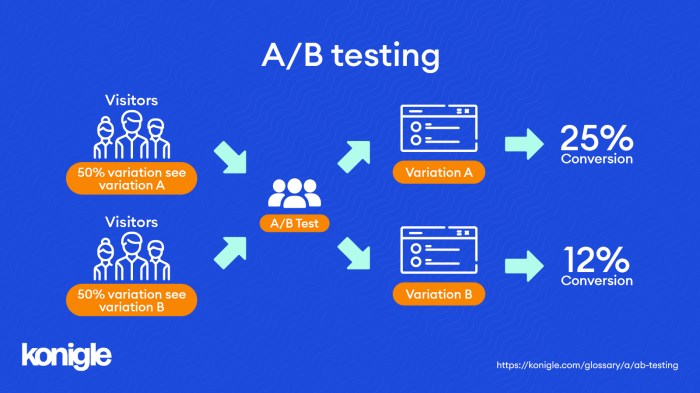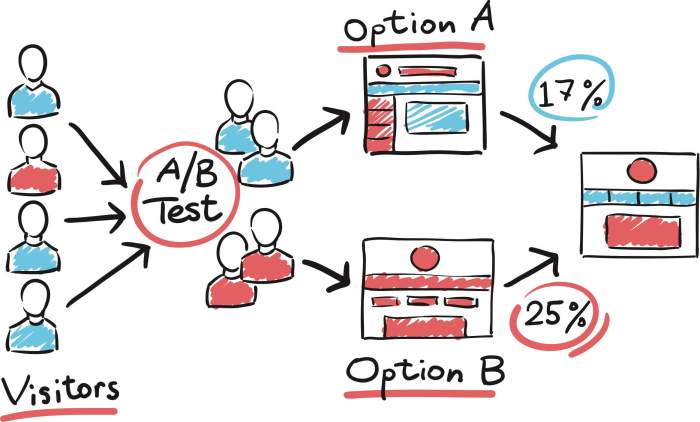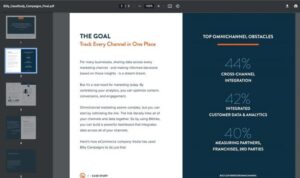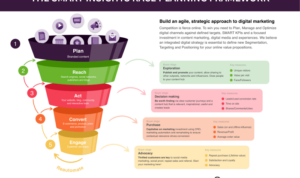Using A/B Testing in Marketing opens up a world of possibilities to fine-tune strategies and boost results. Dive into the realm of data-driven decision-making and optimization with this powerful tool.
Learn how A/B Testing can revolutionize your marketing efforts and propel your campaigns to new heights with targeted insights and practical examples.
Introduction to A/B Testing in Marketing
A/B Testing, also known as split testing, is a marketing strategy used to compare two versions of a webpage, email, or other marketing asset to determine which one performs better. This method involves dividing the audience into two groups and showing each group a different version of the content to see which one generates more engagement or conversions.
Purpose of A/B Testing in Marketing Campaigns
A/B Testing helps marketers make data-driven decisions by providing insights into what elements of their marketing campaigns are most effective in driving desired outcomes. By testing variations of content, design, or calls to action, marketers can optimize their strategies to improve conversion rates and overall performance.
Benefits of A/B Testing in Marketing Strategies
- Identifying High-Performing Elements: A/B Testing allows marketers to pinpoint which elements of their campaigns are driving positive results, enabling them to focus resources on what works best.
- Optimizing Conversion Rates: By testing different versions of landing pages or emails, marketers can determine which layout, copy, or visuals lead to higher conversion rates and implement those changes for better results.
- Enhancing User Experience: A/B Testing helps marketers understand user preferences and behavior, leading to improvements in overall user experience and engagement with the brand.
- Increasing ROI: By continuously testing and refining marketing strategies through A/B Testing, marketers can maximize their return on investment by investing in tactics that deliver the best results.
Setting Up A/B Tests

When it comes to setting up A/B tests in marketing, there are several key steps to follow. First and foremost, it is crucial to clearly define your objectives before conducting any tests. This will help guide your testing process and ensure that you are focused on what you want to achieve.
Importance of Defining Clear Objectives
- Identifying the specific goals you want to achieve through the A/B test.
- Determining the metrics that will be used to measure the success of the test.
- Setting a clear hypothesis to test different variables.
Variables to Test using A/B Testing
- Call-to-action buttons: Testing different colors, text, or placements to see which drives more clicks.
- Email subject lines: Testing variations to see which ones result in higher open rates.
- Pricing strategies: Testing different price points to determine the most effective one for conversions.
Analyzing A/B Test Results

Once you have conducted your A/B tests, the next crucial step is to analyze and interpret the results to draw meaningful insights and make informed decisions.
Common Metrics for Evaluating A/B Tests, Using A/B Testing in Marketing
- Conversion Rate: This metric measures the percentage of users who took a desired action, such as making a purchase or signing up for a newsletter, out of the total number of visitors.
- Click-Through Rate (CTR): CTR calculates the percentage of users who clicked on a specific element, like a button or link, out of the total number of users who saw it.
- Bounce Rate: Bounce rate indicates the percentage of users who landed on a page but left without interacting further. A high bounce rate could suggest a lack of relevance or usability.
- Revenue Per Visitor (RPV): RPV measures the average revenue generated from each visitor to your website, providing insights into the overall profitability of your A/B test variations.
Best Practices for Drawing Insights
- Ensure Statistical Significance: Make sure your sample size is large enough to produce reliable results and that any observed differences are not due to chance.
- Segment Your Data: Analyze the results based on different user segments to understand how variations perform with specific audiences or demographics.
- Consider User Experience: Look beyond the numbers and consider qualitative feedback to understand why users may be responding differently to each variation.
- Iterate and Test Continuously: Use the insights gained from each A/B test to inform future experiments and continuously optimize your marketing strategies.
Implementing Changes Based on A/B Test Results: Using A/B Testing In Marketing
After analyzing the results of A/B tests, marketers can leverage the data to make informed decisions that drive their marketing strategies forward.
Using Data to Drive Decisions
Marketers can use A/B test results to identify which variations of their marketing campaigns perform better with their target audience. By analyzing metrics such as click-through rates, conversion rates, and engagement levels, they can determine which elements are resonating with customers and which ones need improvement.
- By implementing changes based on A/B test results, marketers can optimize their campaigns for better performance and ROI.
- For example, a clothing retailer may use A/B testing to compare two different email subject lines to see which one leads to higher open rates. Based on the results, they can then tailor future email campaigns to include subject lines that are more appealing to their subscribers.
- Continuous testing and iteration allow marketers to refine their strategies over time, ensuring that they are always adapting to the evolving preferences of their audience.
Successful Marketing Campaigns Optimized with A/B Testing
Many successful marketing campaigns have been optimized using A/B testing, leading to significant improvements in key performance metrics.
“A/B testing helped our company increase our conversion rate by 25% within just a few months of implementing changes based on the test results.” – Marketing Director at a tech startup
- A popular e-commerce platform utilized A/B testing to compare different versions of their homepage layout. By analyzing user behavior and preferences, they were able to create a more user-friendly design that resulted in a 30% increase in average session duration.
- A software company tested two variations of their pricing page to see which one led to more sign-ups for their product. The winning version, which emphasized the value of their software in a more compelling way, increased sign-up rates by 20%.
Importance of Iterative Testing and Continuous Improvement
Iterative testing and continuous improvement are crucial in marketing strategies to ensure that campaigns are always optimized for the best possible results.
- Marketers should view A/B testing as an ongoing process rather than a one-time experiment. By continuously testing new ideas and analyzing results, they can stay ahead of the competition and meet the changing needs of their audience.
- Regularly evaluating and adjusting marketing strategies based on A/B test results allows companies to adapt quickly to market trends and consumer behavior, ultimately leading to more effective campaigns and higher returns on investment.












